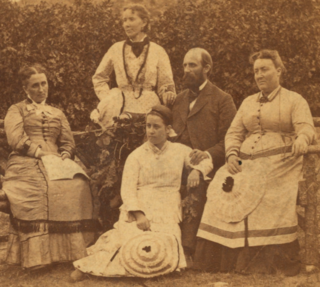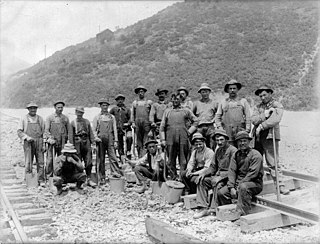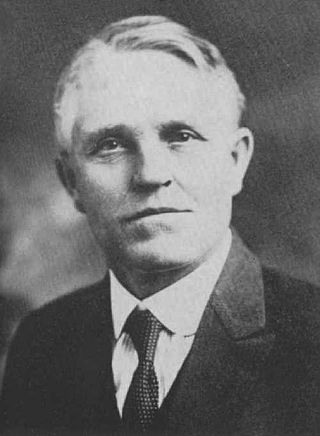
Polygamy was practiced by leaders of the Church of Jesus Christ of Latter-day Saints for more than half of the 19th century, and practiced publicly from 1852 to 1890 by between 20 and 30 percent of Latter-day Saint families.

The Liberal Party was a political party established in the latter half of the 1800s in Utah Territory before the national Democrats and Republicans established themselves in Utah in the early 1890s.

The 1890 Manifesto is a statement which officially advised against any future plural marriage in the Church of Jesus Christ of Latter-day Saints. Issued by Church President Wilford Woodruff in September 1890, the Manifesto was a response to mounting anti-polygamy pressure from the United States Congress, which by 1890 had disincorporated the church, escheated its assets to the U.S. federal government, and imprisoned many prominent polygamist Mormons. Upon its issuance, the LDS Church in conference accepted Woodruff's Manifesto as "authoritative and binding."

Frank Jenne Cannon was the first United States Senator from Utah, who served from 1896 to 1899.

Thomas Kearns was an American mining, banking, railroad, and newspaper magnate. He was a US Senator from Utah from 1901 to 1905. Unlike the predominantly Mormon constituents of his state, Senator Kearns was Catholic.

Gaskell Romney is regarded as a patriarch of the Romney family, a U.S. political family. Romney was born in St. George, in what was then the Utah Territory, the son of Miles Park Romney and Hannah Hood Hill.

The 1900 United States presidential election in New York took place on November 6, 1900. All contemporary 45 states were part of the 1900 United States presidential election. Voters chose 36 electors to the Electoral College, which selected the president and vice president.

The 1900 United States presidential election in Virginia took place on November 6, 1900, as part of the 1900 United States presidential election. Voters chose 12 representatives, or electors to the Electoral College, who voted for president and vice president.

Early in its history, the Church of Jesus Christ of Latter-day Saints had a series of negative encounters with the federal government of the United States. This led to decades of mistrust, armed conflict, and the eventual disincorporation of the church by an act of the United States Congress. The relationship between the church and the government eventually improved, and in recent times LDS Church members have served in leadership positions in Congress and held other important political offices. The LDS Church becomes involved in political matters if it perceives that there is a moral issue at stake and wields considerable influence on a national level with over a dozen members of Congress having membership in the church in the early 2000s, and about 80% of Utah state lawmakers identifying as LDS.

The 1916 United States presidential election in Utah took place on November 7, 1916. All contemporary forty-eight states were part of the 1916 United States presidential election. State voters chose four electors to the Electoral College, who voted for president and vice president. This was the first election featuring as a distinct voting unit Duchesne County, which had been split from Wasatch County in 1915.

The 1904 United States presidential election in Utah was held on November 8, 1904, throughout all forty-five contemporary states as part of the 1904 United States presidential election. State voters chose three representatives, or electors to the Electoral College, who voted for president and vice president.

The 1896 United States presidential election in Utah was held on November 3, 1896 as part of the 1896 United States presidential election. Voters chose three representatives, or electors to the Electoral College, who voted for president and vice president. This was the first time Utah participated in a presidential election, having been admitted as the 45th state on January 4 of that year.

The 1900 United States presidential election in Florida was held on November 6, 1900. Florida voters chose four representatives, or electors to the Electoral College, who voted for President and Vice-President.

The 1896 United States presidential election in Idaho took place on November 3, 1896. All contemporary 45 states were part of the 1896 United States presidential election. State voters chose three electors to the Electoral College, which selected the president and vice president.

The 1896 United States presidential election in Kansas took place on November 3, 1896. All contemporary 45 states were part of the 1896 United States presidential election. Kansas voters chose ten electors to the Electoral College, which selected the president and vice president.

The 1900 United States presidential election in Colorado took place on November 6, 1900. All contemporary 45 states were part of the 1900 United States presidential election. Voters chose four electors to the Electoral College, which selected the president and vice president.

The 1900 United States presidential election in North Carolina took place on November 6, 1900. All contemporary 45 states were part of the 1900 United States presidential election. Voters chose 11 electors to the Electoral College, which selected the president and vice president.

The 1908 United States presidential election in Washington took place on November 3, 1908. All contemporary 46 states were part of the 1908 United States presidential election. Voters chose five electors to the Electoral College, which selected the president and vice president.

The 1908 United States presidential election in Oregon took place on November 3, 1908. All contemporary 46 states were part of the 1908 United States presidential election. State voters chose four electors to the Electoral College, which selected the president and vice president.

The 1895 Utah gubernatorial election was held on November 3, 1895. It was the first gubernatorial election in the state of Utah and it was held before it became a state on the 4th of January, 1896, to set up the machinery for the new state. Republican Heber Manning Wells defeated Democratic nominee John Thomas Caine with 50.32% of the vote. Wells' first term was to run for five years, until the next general election in 1900. Also, Populist Henry W. Lawrence ran but only won 4.95% of the vote.
























